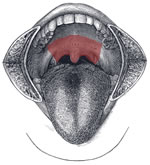Soft Palate Lifting
- This post is available for download as an audio file, so you can do the work along with the recording.
 Nasal consonants are speech sounds made with the soft palate dropped, which allows the sound of your voice to flow out through your nose. By exploring the nasal consonants that are made on the soft palate, we can exercise the action of the muscles that lift and drop the soft palate, and thereby increase awareness of the actions of the palate.
Nasal consonants are speech sounds made with the soft palate dropped, which allows the sound of your voice to flow out through your nose. By exploring the nasal consonants that are made on the soft palate, we can exercise the action of the muscles that lift and drop the soft palate, and thereby increase awareness of the actions of the palate.
This exercise assumes that you've already read and done the Soft Palate Basics exercise; if you haven't done that yet, you might want to go and read that first.
Feel the Drop
One issue with the soft palate is that there are fewer nerve endings in the back of the mouth, and so there is less awareness of that area. This is good, in that it can reduce your gag reflex, but when it comes to finding more clear articulation of the soft palate, it can make matters challenging. Some people have both a strong gag reflex and limited awareness of their palate, so it's hard to feel, and what they do feel makes them feel sick. For those people, I advise working in short bursts, and taking care to only do as much as you need.
The nasal consonant sound that's made at the back of your mouth is heard in the "ng" sound heard at the ends of words like "thing" or "song." That consonant is made with your soft palate dropped to meet the back of your tongue, closing off the air going to your mouth, and redirecting it to your nose. If you say a word like "song" and sustain the "ng" sound (IPA [ŋ]), you should be able to feel the air, and the vibrations of the sound you're making, passing through your nose, and not out your mouth (put a hand over your mouth and block your nose if you don't believe me.) When you shift from the "ah" vowel of "so-ng" to the [ŋ] sound,the air, sound & vibrations should move from mouth to nose. Hopefully you can at least feel the action of the back of the tongue rising to meet the dropped soft palate. Now try to increase your awareness by saying "ah" and going back and forth between an "oral" sound and a "nasal" one, where the sound of the vowel vibrates in your nose. (For those who care about IPA, the sound here is the vowel [ɑ], and to denoted nasality we add a little tilde diacritic over the symbol, to make it [ɑ̃]. )
NG-K
As you remember from the Soft Palate Basics exercise, [k] is a handy sound for exploring the soft palate, as that consonant sound is made with the back of tongue up against a raised soft palate. Now, let's combine it with the [ŋ] sound, to make [ŋk]. Sustain the "ng" sound, and then raise your soft palate to clip off the nasal sound with a [k]. Don't bother to release the "k," just stop the airflow by lifting your soft palate. (In IPA this is called "No Audible Release" and we notate it [ŋk̚].)
Down to Go Up
Now try making that sound pairing again, but after you've made the [ŋ] sound, pull your tongue down in your mouth. This is a fairly odd thing to do, and it may take a few tries to get it. It also feels quite weird, as pulling your tongue root down (which is stuck to your soft palate) will cause your soft palate to stretch. Most people will agree that that feels kinda gross, to put it bluntly. If you put the "k" stop with no audible release on the end, you'll get a very weird feeling in deed.
The final exploration for this step is to drop the soft palate to make the [ŋ] sound, and then merely lift the soft palate to make an open [ɑ]. The tongue should stay static, or as close to it as possible, and the action will live in the soft palate. It has been well documented that lifting your cheek muscles helps to lift your soft palate, so if you think of a pseudo-smile as you do this, it will often help to establish the connection.
- This post is available for download in a condensed format, so you practice lifting your soft palate, and once you know how, you can work along with the recording.
Next Step: Lip Isolations